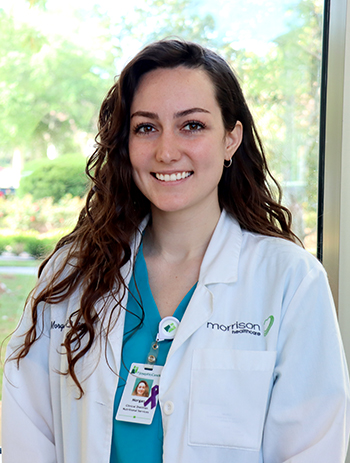What to expect if you need a feeding tube during your cancer treatment
Cancer, Nutrition
When you are diagnosed with certain cancers (most commonly head and neck), our healthcare team may decide you need a feeding tube for a variety of reasons, including difficulty swallowing or malnourishment. It may sound scary, but for many it’s likely a temporary solution to keep you as nourished as possible throughout your treatment.
“Adequate nutrition and maintaining your weight are very important during treatment. Staying nourished can prevent weight loss and malnutrition and help to increase your treatment tolerance and overall energy,” says Morgan Fink, registered dietitian at the Nancy N. and J.C. Lewis Cancer & Research Pavilion. “Typically, if you can maintain your weight, there’s an improved treatment outcome as well as better quality of life.”

Fink and our other LCRP dietitians work directly with patients who require a feeding tube, also known as a PEG tube (percutaneous endoscopic gastrostomy) or PEJ (percutaneous endoscopic jejunostomy). It’s a plastic tube that is placed through the abdominal wall and into the stomach or small intestine. It has a cap on the end for feeding, with use of a syringe.
“I tell patients to look at it as a second mouth, and to think of the syringe as a cup,” Fink says. “When you can’t use your mouth or your throat, think of this as a way to get nutrients into your stomach.”
If you have cancer of the head, neck or esophagus, you may need one. If you are chronically malnourished or simply cannot use your mouth and throat for a long time, a feeding tube can be extra support, Fink says. But, not everyone requires a feeding tube. Our clinical effectiveness teams at the LCRP discuss who needs a PEG/PEJ tube. Some feeding tubes are placed as a precaution prior to beginning treatment, but a patient may never need it. Others may have to rely solely on the tube for nutrition.
Our registered dietitians will work closely with patients who need a feeding tube, typically seeing them within 24 to 48 hours after placement, Fink says. They will help establish calorie goals, select which liquid formula is best for you and how to use it. They also go over hydration, cleaning the tube and using it for medication intake.
Feeding tubes and the formula may be covered under your insurance and the dietitian can help with that also, Fink says. Typically the formula is delivered right to your front door.
How long you will need the feeding tube will depend on your treatment. The tube will likely stay in throughout the course of treatment. Depending on how your symptoms resolve after treatment, your healthcare provider will determine if and when it can be removed. Again, not all PEG/PEJ tubes are permanent, Fink stresses.
When the time comes to transition back to an oral diet, you will be referred to a speech therapist and go through a Modified Barium Swallow Study (MBSS), an exam that looks at how you swallow different liquids and foods.
“Infrequent swallowing may cause those muscles to begin to atrophy,” Fink says. When there is a problem in any step of the swallowing process, it can cause coughing, choking or aspiration, which is when food or liquids enter your lungs.
After the MBSS, the speech therapists will work with your doctor to make dietary recommendations for you to follow. Our LCRP dietitians also will be here to help you along the way, Fink says.
Coming Thursday: Learn more about a Modified Barium Swallow Study